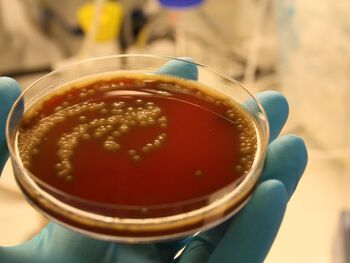The case, though, is perhaps more connected to influencing an already ongoing «conversation» between bacteria. In their struggle to achieve their persistent goal, which is survival, bacteria participate in a complex form of communication with each other. This can, in turn, lead to disease – often serious disease.
Antibiotic resistence as a result of bacterial communication

– If we manage to get to the bottom of how the bacteria talk together, and what they achieve by communicating the way they do, it will give us a good foundation to develop methods that will prevent infectious diseases, such as pneumonia, or the spread of antibiotic resistance, Ph.d-candidate Roger Junges explains. In his doctoral project, he has shown how different factors in three different species of streptococci, which inhabit the oral cavity and the upper respiratory tract, can influence their communication.
The way bacteria communicate often regulates different functions such as biofilm formation on the teeth, also known as «dental plaque», and gene exchange. The latter plays precisely a role in how antibiotic resistance has developed into becoming a serious threat to public health: bacteria take up genes available in the environment, and when these genes encode resistance to antibiotics, bacteria become protected against this important medicine.
Learning the «language» of the bacteria
Recent research has shown now that bacteria are microorganisms that «talk» together to coordinate collective behaviour and cooperation, as opposed to earlier assumptions that they are separate cells that act on a completely individual basis. Junges is contributing to the development of this knowledge in his research.

Some streptococci are harmless, while others can cause various forms of disease. One of the discoveries Junges has made was to find out how the bacterial species Streptococcus mutans, Streptococcus pneumoniae and Streptococcus mitis regulate their methods of absorbing DNA from their surroundings. By editing the DNA of the streptococci, the group has also been able to identify a positive feedback loop for how S. mutans determines the frequency of its own gene uptake.
– What we have found enables us to better intervene in the communication systems of the bacteria and thus influence them to act differently. S. mutans, for example, is a species of bacteria that plays an essential role in the development of caries, also known as tooth decay, Junges explains, a dentist himself.
In his studies, he has used a number of different techniques, such as so-called RNA and DNA sequencing, biofilm analysis and animal models. He also refers to the group’s very own new method for quickly editing the genome of streptococci.– This means that we can remove genes, add DNA sequences and make almost any changes to the genetic codes that we desire, which is in itself very fascinating, Junges explains.
Lethal diseases
One of the greatest discoveries made in his doctoral project can contribute to reducing lethal diseases caused by the bacterial species S. pneumoniae in the future.
This species, which is closely related to S. mitis, is the most important cause of pneumonia, but it can also result in other serious infections, such as meningitis and septicaemia. It is estimated that over one million people die from the consequences of this species each year, and most of the victims are children under the age of five.
Junges and his colleagues at the Department of Oral Biology have succeeded in identifying a new communication system that S. pneumoniae uses to protect itself. Through internal communication, bacteria increase the expression of the capsule that they use to protect themselves as a form of armor, which is part of their efforts to survive.
If you can’t beat them, join them
Since they know the strategy bacteria use to protect themselves, the researchers also believe that they will in time be able to influence this protection strategy in the opposite direction, and hopefully outmanoeuvre bacteria in the future. Instead of finding strategies to penetrate the armor, they will use a more «diplomatic» approach and try to influence the bacteria through communication.
There is still a long way to go until the researchers can enter into ongoing bacterial communication and control it so that infection by resistant bacteria and diseases can be stopped. – We have nevertheless made considerable progress, says Junges. – And this makes it even more motivating to continue our research in this field, the Phd-candidate emphasises, who has published five academic articles in the field in the course of his doctorate.
During his years as a doctoral research fellow, Junges has also received several international awards from the International Association for Dental Research (IADR) for his research: NOF Hatton Award in 2014, Lion Dental Research Award in 2016, and he recently returned from the IADR in San Francisco with the Colgate Research in Prevention Travel Awards.
Junges has been supervised by Professor and leader of the CrossTalk research group, Fernanda Petersen, and Donald A. Morrison from University of Illinois i Chicago. He will defend his Ph.d. at the Department of Oral Biology on Friday June 23.
References
Donald A. Morrison, Rabia Khan, Roger Junges, Heidi A. Åmdal, Fernanda C. Petersen. Genome editing by natural genetic transformation in Streptococcus mutans. J Microbiol Methods 2015; 119:134-41.
Gabriela Salvadori, Roger Junges, Donald A. Morrison, Fernanda C. Petersen. Overcoming the barrier of low efficiency during natural transformation of Streptococcus mitis. Frontiers in Microbiology 2016; 01009 (7).
Rabia Khan, Roger Junges, Heidi A. Åmdal, Tsute Chen, Donald A. Morrison, Fernanda C. Petersen. A positive feedback loop mediated by Sigma X enhances expression of the streptococcal ComR regulator and its cognate pheromone. Scientific Reports. Accepted for publication.
Roger Junges, Gabriela Salvadori, Sudhanshu Shekhar, Heidi A. Åmdal, Jimstan N. Periselneris, Tsute Chen, Jeremy S. Brown, Fernanda C. Petersen. Virulence and fitness attenuation by the Rgg/SHP cell-to-cell signaling system in Streptococcus pneumoniae. Submitted 2017.
Roger Junges, Rabia Khan, Yanina Tovpeko, Heidi A. Åmdal, Fernanda C. Petersen FC, Donald A. Morrison. Markerless genome editing in competent streptococci. Methods Mol Biol. 2017; 1537:233-247.






